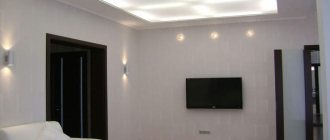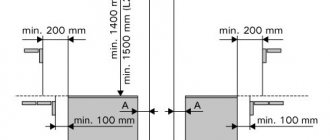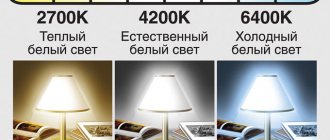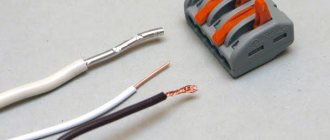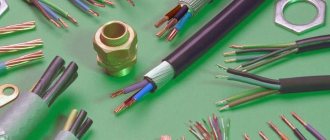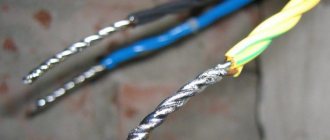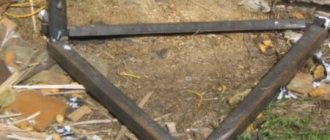Property owners often have difficulty deciding which wiring is better - copper or aluminum. This question faces private developers and owners of city apartments that are planning major renovations. Not only the operational characteristics of the housing, but also the safety of the owners’ residence depends on the correctness of the decision made. In order not to make a mistake in choosing electrical wiring, you need to understand the pros and cons of each material, find out the common points and fundamental differences.
What to look for when choosing wires
Diagram of copper and aluminum wires
When choosing between copper or aluminum for wiring, you need to take into account several criteria on which the efficiency of the electrical system depends.
You need to pay attention to the following nuances:
- Locations of sockets, lighting fixtures, packet and key switches. Based on the diagram, you can calculate the required cable footage.
- The total power of devices that will simultaneously be connected to the network. The result is an indicator of the maximum current load of the wires.
- Socket standard. They are adapted for connecting cores whose diameter does not exceed 2.5 mm. Current load and electrical conductivity of metals are correlated.
- Material cost. This parameter should be the last thing to focus on, since safety comes first.
We should not forget about such criteria as durability. Replacing communications is too expensive and time-consuming to carry out once every few years
Why can't you twist aluminum and copper cables?
Of course, if you are planning to rewire your home and are unable to install all the electrical wires made of copper, you can combine these two types of wiring. In other words, you can use aluminum cables to supply current to lighting fixtures and copper wires to supply current to outlets or powerful electrical appliances. At the same time, in some places it will be necessary to connect copper and aluminum wiring.
It should be noted from the outset that direct contact between copper and aluminum is, at a minimum, not recommended. This means that it is impossible to twist electrical wires made of two metals. Why? The reason lies in their physical properties. These two metals have different conductivities and, as a result, the junctions between them will heat up. This is also facilitated by the presence of oxidizing films.
If we talk about the oxidation film on copper wiring, then it can conduct current and therefore does not greatly affect heating. But the same film on an aluminum electrical wire has a strong resistance and, accordingly, passes less current. This fact increases the heating. As the cables heat up, they expand. Since copper is a harder metal than aluminum, copper electrical wire leads to some deformation of the aluminum wire. As a result, when cooling occurs, the connection itself looks slightly different.
After heating and cooling several times, the connection becomes loose, leading to problems such as overheating, sparking, and burning. The appearance of a galvanic couple also occurs. However, it only appears when moisture gets into the connection. Otherwise, this pair will not form. A galvanic couple appears because at the junction of such wires, which we call copper and aluminum, dissociation of the oxides of the electrical wires begins. This process involves the breakdown of the oxide into charged ions.
After this, charged ions of copper and aluminum oxides become direct participants in the process of current movement. As a result, they transfer charge and also move. This feature leads to the destruction of the metal. Ultimately, voids and cavities form in the wiring. They in turn reduce the cross-section and ability of the wiring to pass current.
The end result is overheating of the joints. As we have already noted, this process occurs only in the presence of moisture. And the more moisture there is at the twisting site, the faster the dissociation becomes. I think you have already understood that it is impossible to allow moisture to get into the connection, and also to allow direct contact between copper and aluminum wires.
Properties of aluminum
Aluminum wiring bends easily, but breaks quickly.
Aluminum belongs to the category of light, chemically and biologically inert metals with a specific gravity of 2700 kg/m³. The material is safe for humans and the environment.
Advantages of aluminum:
- Affordable price. The price is determined by the lower melting point and lower production costs than other metals.
- Plastic. The wire bends well, maintaining its shape. The cores are given any configuration required for the job.
- Formation of a protective layer. After stripping, the metal surface is covered with a thin layer, which prevents its oxidation throughout its entire volume.
However, aluminum has the following disadvantages:
- High degree of resistance to electron flow. This causes the lines to heat up, which can cause the finishing materials to catch fire.
- High level of thermal expansion. Because of this, weakening of contact connections occurs. When lines with a high load are frequently switched on and off, the circuit becomes disconnected.
- Oxidation upon contact with air. The resulting film has poor conductivity, which causes the contacts to overheat and melt the insulation, and the ground line simply ceases to perform its function.
- Short service life. It does not exceed 30 years under average load.
Today, in accordance with GOST requirements, the use of aluminum is prohibited in the construction of residential buildings and engineering structures.
Flaws
Aluminum wiring is characterized by high electrical resistivity.
This resistance is equal to 0.0271 Ohm x mm2/m. Taking this fact into account, the latest editions of the PUE note that in an apartment or house you can only use aluminum wiring whose cross-section exceeds 16 square meters. millimeters. Ultimately, it turns out that to ensure the required level of throughput, you need to use a cable with a large cross-section. In other words, you need to install wiring that is thick. If we compare copper wiring, it has an electrical resistivity that is equal to 0.0175 Ohm x sq. mm/m.
This wiring is more efficient and for use in the home you can use copper cable with a smaller cross-section. As noted above, aluminum is capable of oxidizing and the film formed during this process has poor conductivity. There is one more nuance here: this film is formed from the top of the wire. As a result, there is a slight decrease in its cross-section, and as a result, the resistance increases.
Since the film on aluminum wiring has a high resistance, the transition resistance increases at the junction of individual parts of the wire. As a result, it manifests itself in heating of the wiring in such places. In situations where the load on aluminum wiring increases, it begins to heat up. If the wire has a sufficient cross-section, then there is nothing to worry about. However, if the wiring is not designed for such a load or is used beyond its normal service life, then this will necessarily lead to its heating.
The last fact can be called very bad for connection points. The fact is that when aluminum is heated, its shape and ductility change. Of course, the wire expands. After the load has disappeared and the cable has cooled, it takes on its usual shape. However, after repeated repetition of such processes, the contact between the ends of the electrical wires weakens.
Aluminum is also highly brittle. It increases greatly after it overheats. As for the service life, for aluminum wiring it is 25 years. After this, you need to install a different type of wiring.
Properties of copper
Copper wiring is resistant to twisting and bending
. Copper is a heavy metal with a specific gravity of 8700 kg/m³. This indicator should be taken into account only when laying power lines with a limited safety margin of the supports. In everyday life it can be neglected. The material actively interacts with oxygen, forming an oxide - a patina, which can be seen on statues, fences and souvenirs.
The advantages of copper are as follows:
- Durability. If the line does not run outdoors, it can last 30-50 years depending on the humidity of the room.
- Strength. Copper is resistant to twisting and bending. A high-quality cable can be deformed up to 100 times without losing its performance characteristics.
- High conductivity. The metal allows electrons to pass through easily without being subject to heating or thermal expansion.
- Flexibility. The wiring easily takes the desired position, straightening after the load is removed. It is convenient to work with cables during the installation process.
The material also has disadvantages:
- High price. This is explained by the difficulties of ore mining and the costs of processing it. Melting the concentrate requires a large amount of energy, plus transportation costs.
- Oxidation when interacting with water and air. The resulting film impairs the conductivity of the contacts and contributes to their heating.
When choosing between aluminum or copper wiring, it is advisable to choose the second option, since it has more advantages than disadvantages.
Copper wiring
Copper wiring began to appear after the opening of the Iron Curtain, when imported powerful electrical appliances began to arrive in the country.
The aluminum network that had been used for years began to not withstand such a load and they began to replace it with copper. Apparently, this is why the question arose, which wiring is better, copper or aluminum.
At the very beginning of the article it was said that this is not a completely correct question. Under nominal conditions, both copper and aluminum conductors behave the same.
They just have slightly different metrics that need to be taken into account. In what ways is copper considered better than aluminum?
Advantages
There are two main arguments in favor of copper:
- strength;
- conductivity.
Indeed, copper, due to its higher density, can withstand greater mechanical loads than aluminum.
Due to its higher melting point, copper retains its shape better, which is especially important in contacts. The conductivity of copper is 1.7 times better than that of aluminum, which makes it possible to use wires of smaller diameter that can carry the same current
| Permissible current load on wires and cables with copper and aluminum conductors in polyvinyl chloride insulation (type VVG, VVGng, AVVG, etc.) - table GOST 31996-2012. |
| In the air (corrugation, trays, box, etc.) | Section, mm2 | In the ground | ||||||||||
| Copper conductors | Aluminum conductors | Copper conductors | Aluminum conductors | |||||||||
| Current, A | power, kWt | Current, A | power, kWt | Current, A | power, kWt | Current, A | power, kWt | |||||
| 220 V | 380 V | 220 V | 380 V | 220 V | 380 V | 220 V | 380 V | |||||
| 21 | 4,62 | 13,81 | — | — | — | 1,5 | 27 | 5,94 | 17,75 | — | — | — |
| 27 | 5,94 | 17,74 | 21 | 4,62 | 13,81 | 2,5 | 36 | 7,92 | 23,66 | 28 | 6,16 | 18,41 |
| 36 | 7,92 | 23,66 | 29 | 6,38 | 19,06 | 4 | 47 | 10,34 | 30,89 | 37 | 8,14 | 24,32 |
| 46 | 10,12 | 30,24 | 37 | 8,14 | 24,32 | 6 | 59 | 12,98 | 38,78 | 44 | 9,68 | 28,92 |
| 63 | 13,86 | 41,42 | 50 | 11 | 32,87 | 10 | 79 | 17,38 | 51,93 | 59 | 12,98 | 38,78 |
| 84 | 18,48 | 55,22 | 67 | 14,74 | 44,04 | 16 | 102 | 22,44 | 67,05 | 77 | 16,94 | 50,62 |
| 112 | 24,64 | 73,62 | 87 | 19,14 | 57,19 | 25 | 133 | 29,26 | 87,43 | 102 | 22,44 | 67,05 |
| 137 | 30,14 | 90,06 | 106 | 23,32 | 69,68 | 35 | 158 | 34,76 | 103,87 | 123 | 27,06 | 80,86 |
| 167 | 36,74 | 109,78 | 126 | 27,72 | 82,83 | 50 | 187 | 41,14 | 122,93 | 143 | 31,46 | 94,00 |
| 211 | 46,42 | 138,71 | 161 | 35,42 | 105,84 | 70 | 231 | 50,82 | 151,86 | 178 | 39,16 | 117,01 |
| 261 | 57,42 | 171,58 | 197 | 43,34 | 129,51 | 95 | 279 | 61,38 | 183,41 | 214 | 47,08 | 140,68 |
| 302 | 66,44 | 198,53 | 229 | 50,38 | 150,54 | 120 | 317 | 69,74 | 208,4 | 244 | 53,68 | 160,41 |
| 346 | 76,12 | 227,46 | 261 | 57,42 | 171,58 | 150 | 358 | 78,76 | 235,35 | 274 | 60,28 | 180,12 |
| 397 | 87,34 | 260,98 | 302 | 66,44 | 198,53 | 185 | 405 | 89,1 | 266,25 | 312 | 68,64 | 205,11 |
Flaws
What is a plus for aluminum is a minus for copper:
- price;
- weight.
Copper itself is about 4 times more expensive than aluminum, so to make repairs less expensive, it makes more sense to use aluminum. Secondly, it's weight. With the same cross-section, an aluminum wire will be much lighter than copper.
Which conducts current better?
This indicator determines such properties of the wiring as its maximum power, durability and fire safety.
The following operational characteristics of the laid line depend on conductivity:
- heating losses from electron flow;
- preservation of current parameters, which is important for sensitive devices;
- the degree of increase in cable temperature during operation of powerful consumers;
- the presence or absence of a smell from melting and burning wiring in the room.
To understand which conducts current better - copper or aluminum, you can compare the degree of their resistance. The lower this indicator, the lower the likelihood of adverse events occurring.
This indicator is:
- copper - 0.018 Ohm×mm²/m;
- aluminum - 0.028 Ohm×mm²/m.
Copper conducts current more than 1.5 times better. Resistance compensation is achieved by increasing the cross-section of the cable cores.
How to choose the right section and brand of SIP
So what kind of cable should be used to bring electricity into the house? Many people resort to using SIP cable; it is allowed in many electrical industries and even in high voltage lines up to 35 kW.
This cable has its own design feature - phase wires, most often in the amount of three, wrap around the fourth - zero. Therefore, the appearance of SIP resembles a rope twisted into a spiral. High-quality LDPE or XLPE polyethylene is used to insulate conductors. These types of materials have high resistance and a long service life, which allows them to be used even with sudden temperature changes.
The core, which is located in the middle and has zero potential, is made of aluminum alloy. Sometimes the zero does not have its own insulation, which is required for phase conductors.
The SIP cable has one serious drawback - due to the presence of insulation, the cable is insufficiently cooled, so the current loads allowed are lower than those of uninsulated conductors
When choosing SIP, you should pay attention to insulation:
- With insulation made of thermoplastic polyethylene, temperature loads of up to 70 degrees are allowed. Suitable for this parameter: SIP-1, SIP-1A, SIP-4, SIPn-4.
- When choosing cross-linked polyethylene as an insulating material, temperature loads of up to 90 degrees are allowed. Overload mode indicators and short circuit current parameters also increase. Such performance characteristics have: SIP-2, SIP-2A, SIPs-4, SIP-3, PEV and PEVG.
The SIP cross-section is also determined by power consumption, the formula is presented above.
Which wiring material is better?
Types of copper wire connections
With all the advantages of aluminum, one should not forget about its disadvantages. The main one, apart from mechanical characteristics, is low conductivity. It is impossible to endlessly increase the diameter of the cable, since household appliances and channels laid in the walls are not designed for this. We should not forget about such a factor as the fragility of the metal. After several years of use, it may burst when replacing an outlet or meter. It is not advisable to twist it in the socket box, as it will not last long. Choosing aluminum will provide good savings on the purchase of materials, but subsequent repair costs may negate this.
Copper also has its disadvantages, but they are offset by a large number of advantages. Even the process of pulling the cable through the channel is easier, since it bends well without any tendency to break or break. It is worth remembering about low resistance. By installing a line with 2.5 mm² conductors, you can use as powerful consumers in your home as the common house line allows.
To summarize, we can recommend that craftsmen make their choice in favor of copper products. If the budget is limited, you can combine materials using modern switching means.
Subtotal
Which wire is better? From a performance standpoint, copper is more preferable. Based on cost, aluminum wires are cheaper. And here it is important to make a decision - to save on your safety or not.
RELATED ARTICLES ON THE TOPIC:
- Determination of wire diameter abroad. AWG and SWG When designing equipment based on foreign literature, radio amateurs have to deal with determining the diameter of the wire, because the latter in English-language literature is designated in the form of conventional numbers (caliber). There are two standards. AWG - American Wire Gauge - American standard, and SWG - Standard Wire Gauge - British standard. Defining...
- New Russian Callsign Prefix System If you have been on the HF bands lately, you may have noticed that a number of new prefixes are in use by stations in the Russian Federation. Here is a summary of the changes recently adopted by the Russian telecommunication authorities….
- All about digital communications A personal computer is one of the most important components of a modern amateur radio station. Moreover, computers are the basic devices of radio stations that use SDR transceivers or operate on the air only using digital modes of radio communication. Long gone are the noisy mechanical teletype machines and monochrome cathode ray tubes, which were used respectively for...
- Checking the integrity of files using the MD5 checksum It often happens that a downloaded file from the Internet arrives damaged. The reasons may be different, server errors sending files; antiviruses that make changes to files; download errors in multi-threaded mode, errors on the communication line when transferring files. The end result is always the same, either the file does not open or does not run...
- How to distribute the Internet from a computer on Windows 10 We are all accustomed to the fact that modern phones have the “Internet distribution” function, when the phone acts as an access point and a small Wi-Fi router. A similar feature is available in Windows 10. If your computer is equipped with Bluetooth or Wi-Fi, it can distribute the Internet to nearby devices, which...
- Combating reverse polarity RV4LX offered a solution to combat reverse polarity...
- How do I splice a cable...
- About the situation with the call signs EZ (Turkmenistan) Dear colleagues! I received a letter from Bernie McClenny (W3UR) with a request to clarify the amateur radio situation in Turkmenistan (EZ). And also, having read the discussion of this situation on the pages of the KV portal, I want to report the following...
Useful tips
The connection of wires must comply with safety rules.
The cable layout in the apartment consists of an upper and lower level. The lower one has sockets designed to power consumers, the power of which can reach 2 kW: washing machines, boilers, microwave ovens. In order not to expose the lines to the risk of overheating and burning, it is advisable to install a copper cable with the maximum cross-section of conductors allowed for household outlets.
The upper level is used to power doorbells, ceiling and wall lamps. These products consume a minimal amount of electricity, especially if they are equipped with modern LED lamps. You can run a thin and inexpensive aluminum cable on top, the power reserve of which is sufficient with a large reserve. With this solution, a separate issue arises of a safe way to join two incompatible metals.
Conductive paste
To avoid problems with contacts after installation, you can use one of the following devices:
- Clamp. The product consists of 3 steel plates. The cores are inserted between them, after which the plates are tightened with bolts.
- Bolt with 2 iron washers. The ends of the cores are twisted into rings and placed on the axle, and washers are installed between different materials. Tightening the nut ensures reliable contact.
- Spring switch. Its terminals are treated with a special anti-corrosion lubricant. The cores are inserted into the grooves and secured with spring levers.
- Pads. They are a steel strip with contacts pressed into a plastic case. The ends of the cable are inserted into the holes where they are tightened with bolts. The products can be used to connect 2-10 pairs of wires.
To avoid oxidation of wires, copper should be soldered, and aluminum should be coated with a special conductive paste.
Connectors for wires and cables
Connectors are special devices that facilitate the connection of two or more conductors. There are screw and clamping mechanisms.
Screw terminals
Used to connect wires of different materials and different diameters. An exception is multi-core electrical wires, which are crimped with special lugs. Also, screw clamps can damage aluminum wires, so it is better not to use them for such material.
Power clamp
In such clamps, the stripped conductor is placed in the hole to the end. There it is automatically fixed by a pressure plate. Clamps can be used to secure copper and aluminum wires.
Clips
To install the wire, the clip clamp is placed in a vertical position, the wires are inserted inside, and then the clamp must be moved to a horizontal position. Plus, you can make adjustments.
Spring clamps
PPE caps are used as spring clips. Thanks to them, you can quickly make contact between two wires of similar diameters
It is important to choose the correct clamp, otherwise the contact will be unreliable
Spring terminals
Wago spring terminals ensure reliable contact quickly and efficiently. However, over time, the spring may weaken or overheat.
Connection clamps
There are two types - electrical and electrical. The only difference is the current load. The connection takes place inside the device.
§ 45. Calculation of conductor resistance. Resistivity
We know that the cause of the electrical resistance of a conductor is the interaction of electrons with ions of the metal crystal lattice (§ 43).
Therefore, it can be assumed that the resistance of a conductor depends on its length and cross-sectional area, as well as on the substance from which it is made. Figure 74 shows the setup for conducting such an experiment. Various conductors are included in the current source circuit in turn, for example:
- nickel wires of the same thickness, but different lengths;
- nickel wires of the same length, but different thicknesses (different cross-sectional areas);
- nickel and nichrome wires of the same length and thickness.
The current in the circuit is measured with an ammeter, and the voltage with a voltmeter.
Knowing the voltage at the ends of the conductor and the current in it, using Ohm's law, you can determine the resistance of each of the conductors.
Rice. 74. Dependence of conductor resistance on its size and type of substance
After performing these experiments, we will establish that:
- of two nickel wires of the same thickness, the longer wire has greater resistance;
- of two nickelin wires of the same length, the wire with a smaller cross-section has the greater resistance;
- Nickel and nichrome wires of the same size have different resistances.
We advise you to study Load Break Switch
Ohm was the first to study experimentally the dependence of the resistance of a conductor on its size and the substance from which the conductor is made. He found that resistance is directly proportional to the length of the conductor, inversely proportional to its cross-sectional area and depends on the substance of the conductor.
How to take into account the dependence of resistance on the material from which the conductor is made? To do this, calculate the so-called resistivity of the substance.
Specific resistance is a physical quantity that determines the resistance of a conductor made of a given substance with a length of 1 m and a cross-sectional area of 1 m2.
Let us introduce the letter designations: ρ is the resistivity of the conductor, I is the length of the conductor, S is its cross-sectional area. Then the conductor resistance R will be expressed by the formula
From it we get that:
From the last formula you can determine the unit of resistivity. Since the unit of resistance is 1 ohm, the unit of cross-sectional area is 1 m2, and the unit of length is 1 m, then the unit of resistivity is:
It is more convenient to express the cross-sectional area of the conductor in square millimeters, since it is most often small. Then the unit of resistivity will be:
Table 8 shows the resistivity values of some substances at 20 °C. Specific resistance changes with temperature. It has been experimentally established that for metals, for example, the resistivity increases with increasing temperature.
Table 8. Electrical resistivity of some substances (at t = 20 °C)
Of all the metals, silver and copper have the lowest resistivity. Therefore, silver and copper are the best conductors of electricity.
When wiring electrical circuits, aluminum, copper and iron wires are used.
In many cases, devices with high resistance are needed. They are made from specially created alloys - substances with high resistivity. For example, as can be seen from Table 8, the nichrome alloy has a resistivity almost 40 times greater than aluminum.
Porcelain and ebonite have such a high resistivity that they almost do not conduct electric current at all; they are used as insulators.
Questions
- How does the resistance of a conductor depend on its length and cross-sectional area?
- How to experimentally show the dependence of the resistance of a conductor on its length, cross-sectional area and the substance from which it is made?
- What is the resistivity of a conductor?
- What formula can be used to calculate the resistance of conductors?
- In what units is the resistivity of a conductor expressed?
- What substances are conductors used in practice made from?
Features of connecting wires on the street
When installing a cable line along the street, all connection elements are exposed to external negative factors, such as snow, icing, rain, etc. Therefore, to perform such work, only a hermetically sealed structure that is resistant to ultraviolet rays and low temperatures is required. When making connections on a pole, roof or other open place, piercing clamps are most often used. You may be interested in learning in more detail how to connect SIP with copper cable on the street, because... in this case, the connection of aluminum and copper occurs in the open air.
In rooms, when laying a cable in a wall under plaster, the cable is laid in one piece in the groove, and any connection of even homogeneous metals is undesirable. All connections in a socket or junction box are made in any of the ways described above, suitable for each individual situation.
Advantages
From the very beginning, it should be noted that aluminum wiring is not the most reliable and high-quality and cannot boast of any outstanding merits compared to other types. But, nevertheless, it is precisely this type of electrical wiring that is installed in most old houses and apartments (Khrushchev). So, let’s start with the advantages of this type:
- lightness (aluminum has less weight compared to other metals that are used in electricity as conductors);
- resistance to corrosion (metal when exposed to air instantly oxidizes, forming a film that protects the rest of the wire from further corrosion).
According to chapter 7.1. PUE, clause 7.1.34. Electrical wiring must be carried out using cables with copper conductors. Aluminum cables and wires with core cross-section from 2.5 sq. mm can be used when connecting individual electrical appliances that belong to engineering electrical equipment or when connecting powerful electrical equipment with an aluminum cable with a core cross-section of 16 sq. mm.
In accordance with the above, today aluminum in electrical wiring is used most often in power cables of large cross-section (tens and hundreds of sq. mm.), where the weight and cost of the material are very important factors. The savings in this case can be very significant - aluminum is a cheap metal, and the amount of material used will still allow you to spend less compared to other types of wires. A true example of this is the enormous popularity of SIP wires, the cores of which are made of aluminum. For aerial cable laying, this conductor is one of the most suitable. Moreover, according to the PUE chapter 2.1. clause 2.1.14 and chapter 7.1. clause 7.1.131, the cross-section of the aluminum cable for branching through the air must be at least 16 square meters. mm.
However, aluminum wiring has not been used in new buildings for a long time, and there are reasons for this.


